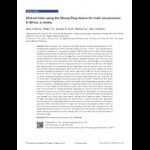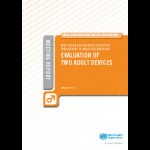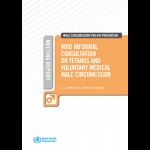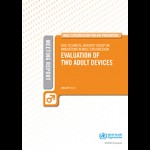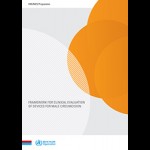Devices for performing voluntary medical male circumcision (VMMC) on adult men and adolescent boys could help make the procedure easier to perform and possibly more accessible and acceptable to potential clients. Before these devices can be incorporated into VMMC programmes, however, research is needed to assess their safety, efficacy, acceptability, and feasibility compared to conventional surgical methods.
The World Health Organization (WHO), through its Technical Advisory Group on Innovations in Male Circumcision (TAG), has identified a minimum series of clinical studies to provide sufficient data to assess the efficacy and safety of a new male circumcision device or method. The following studies, described in the Framework for the Clinical Evaluation of Devices for Male Circumcision, constitute the clinical evaluation component of WHO's prequalification process for male circumcision devices:
-
Initial studies to establish safety and acceptability;
-
At least two independent randomised controlled trials comparing the device against an established method of male circumcision performed by providers skilled in offering either method in settings of intended final use; and
-
At least two field studies of procedures involving relevant populations and types of facilities, performed by suitably trained and qualified mid-level or non-physician providers in settings of intended final use.
These studies were completed for two in situ devices (part or all of the device is in contact with the body for at least 24 hours): the PrePex and the ShangRing.TM WHO’s TAG evaluated this evidence, which was summarised in reports on the TAG's meetings in 20131 and 2014.2 Studies on surgical assist devices have also been undertaken, but none of the devices has entered the prequalification process.
In 2015, and again in 2016, WHO convened technical consultations to review reports of a rare but serious complication — tetanus infection following VMMC3 — and to recommend measures to reduce the risk, including different risk mitigation measures by circumcision method.4
Currently, only the ShangRing is WHO prequalified. In March 2019, WHO amended the original prequalification of the ShangRing, based on the results of additional studies conducted in Kenya,5–7 to include the use of a simpler “no-flip” technique and a topical rather than an injectable anaesthetic.
References
-
World Health Organization. WHO Technical Advisory Group on Innovations in Male Circumcision: Evaluation of Two Adult Devices. Meeting Report, 29–31 January 2013. Geneva: WHO, 2013.
-
World Health Organization. Report of the World Health Organization (WHO) Technical Advisory Group on Innovations in Male Circumcision, 30 September – 2 October 2014. Geneva: WHO, 2015.
-
Dalal S, Samuelson J, Reed J, et al. Tetanus disease and deaths in men reveal need for vaccination. Bull WHO 2016;94(8):613–21.
-
World Health Organization. Tetanus and Voluntary Medical Male Circumcision: Risk According to Circumcision Method and Risk Mitigation. Report of the WHO Technical Advisory Group on Innovations in Male Circumcision – Consultative Review of Additional Information, 12 August 2016. Geneva: WHO, 2016.
-
Barone MA, Li PS, Lee RK, et al. Simplifying the ShangRing technique for circumcision in boys and men: use of the no-flip technique with randomization to removal at 7 days versus spontaneous detachment. Asian J Androl 2019;21(4):324–31.
-
Awori Q, Li PS, Lee RK, et al. Use of topical versus injectable anaesthesia for ShangRing circumcisions in men and boys in Kenya: results from a randomized controlled trial. PLoS One 2019;14:e0218066.
-
Awori QD, Lee RK, Li PS, et al. Use of the ShangRing circumcision device in boys below 18 years old in Kenya: results from a pilot study. J Int AIDS Soc 2017;20(1):21588.
